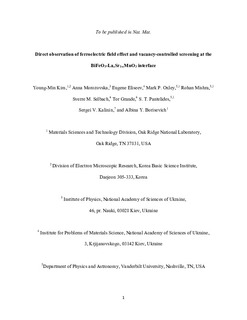Direct observation of ferroelectric field effect and vacancy-controlled screening at the BiFeO3/LaxSr1−xMnO3 interface
Kim, Young-Min; Morozovska, Anna; Eliseev, Eugene; Oxley, Mark P.; Mishra, Rohan; Selbach, Sverre Magnus; Grande, Tor; Pantelides, S. T.; Kalinin, Sergei V.; Borisevich, Albina Y.
Journal article
Submitted version
Permanent lenke
http://hdl.handle.net/11250/2465331Utgivelsesdato
2014Metadata
Vis full innførselSamlinger
- Institutt for materialteknologi [2549]
- Publikasjoner fra CRIStin - NTNU [38127]
Sammendrag
The development of interface-based magnetoelectric devices necessitates an understanding of polarization-mediated electronic phenomena and atomistic polarization screening mechanisms. In this work, the LSMO/BFO interface is studied on a single unit-cell level through a combination of direct order parameter mapping by scanning transmission electron microscopy and electron energy-loss spectroscopy. We demonstrate an unexpected ∼5% lattice expansion for regions with negative polarization charge, with a concurrent anomalous decrease of the Mn valence and change in oxygen K-edge intensity. We interpret this behaviour as direct evidence for screening by oxygen vacancies. The vacancies are predominantly accumulated at the second atomic layer of BFO, reflecting the di erence of ionic conductivity between the components. This vacancy exclusion from the interface leads to the formation of a tail-to-tail domain wall. At the same time, purely electronic screening is realized for positive polarization charge, with insignificant changes in lattice and electronic properties. These results underline the non-trivial role of electrochemical phenomena in determining the functional properties of oxide interfaces. Furthermore, these behaviours suggest that vacancy dynamics and exclusion play major roles in determining interface functionality in oxide multilayers, providing clear implications for novel functionalities in potential electronic devices.
